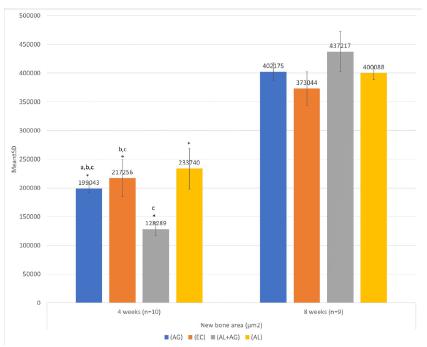Abstract
Purpose:
To performed a histomorphometric and radiological study to evaluate the effects of alendronate sodium administered locally in mandibular bone defects created in rabbits.
Methods:
Two circular defects 5 mm in diameter were created bilaterally in the mandibular corpus of 20 New Zealand rabbits (i.e., four defects per animal). Each defect received one of four treatments: no treatment (EC group), alendronate irrigation (AL group), autogenous bone grafting (AG group), or alendronate irrigation with autogenous bone grafting (AL+AG group). Histomorphometric and radiological assessments were conducted at 4 and 8 weeks after surgery.
Results:
Between-group comparisons of the new bone area, the value of the AL+AG group was significantly lower thanthe remaining three groups at 4 weeks postoperatively. In all groups, the new bone area was significantly larger at 8 weeks than at 4 weeks. The residual graft area at 4 and 8 weeks was significantly higher in the AL+AG group than in the AG group, although it was significantly smaller at 8 weeks than at 4 weeks in both these groups.
Conclusion:
The use of alendronate sodium in conjunction with autogenous bone grafting improves the osteoconductive properties of the graft, enhances graft retention in the defect, and improves ossification.
Key words:
Alendronate; Disphosphonates; Bone Transplantation; Rabbits








